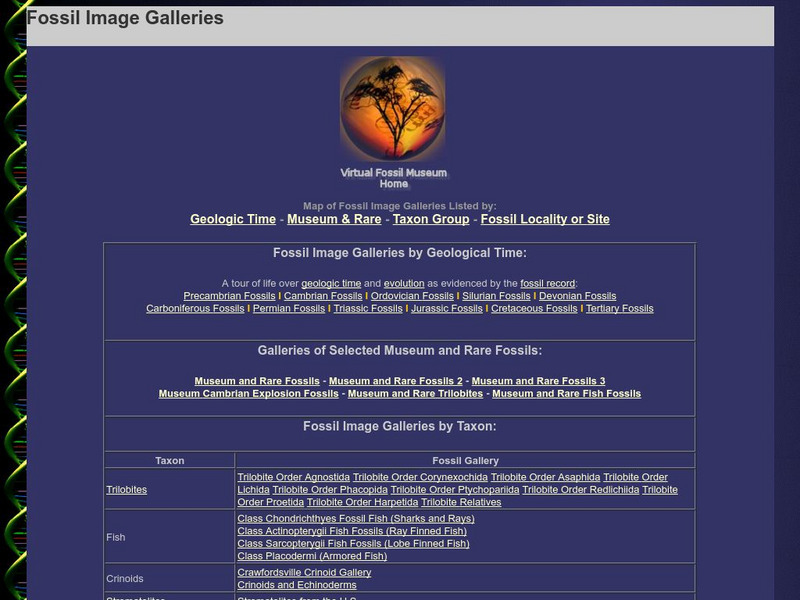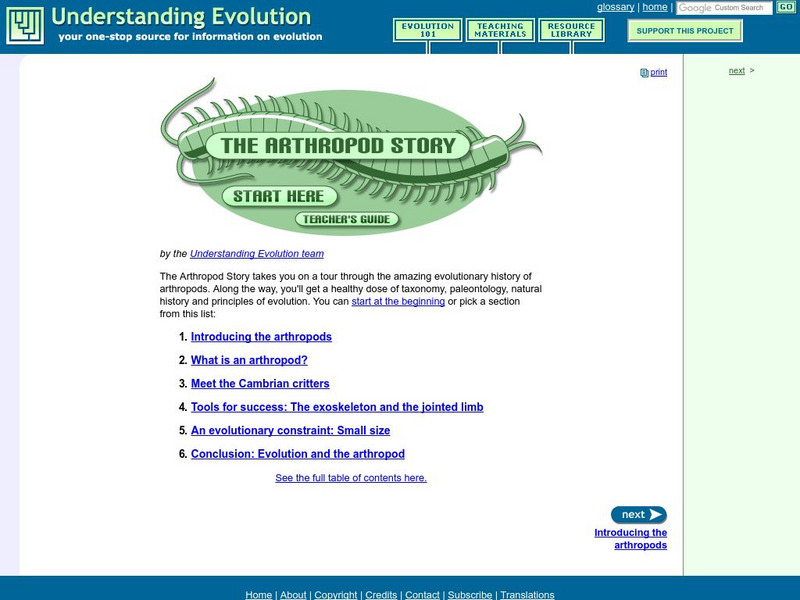American Geosciences Institute
American Geosciences Institute: What Can Fossil Footprints Tell Us?
In this investigation, students examine an image of multiple fossil footprint tracks. They try to construct an explanation for the events that created the pattern of tracks. Even though students come up with different explanations for...
PBS
Pbs Learning Media: Riddle of the Bones
At the online companion Web site of "Evolution," the seven-episode series on PBS, piece together clues to how one of our early ancestors looked as you examine images from four significant fossil finds of Australopithecus afarensis.
Indiana University
Ensi: The Great Fossil Find Lesson Plan
Students hear a story as they "find" bones that you have put in an envelope for them. Their job is to begin assembling the bones as best they can. The students will invariably come up with different configurations--just like scientists...
Biology Corner
Biology Corner: Fossil Record
In this lesson, students use the fossil record to understand the topics of speciation, punctuated equilibrium, and gradualism. Students arrange fictitious animals' fossils by age based on appearance to create a fossil record.
University of California
Ucmp: Learning From the Fossil Record
Fossils provide scientists with clues about Earth's past. This site from the University of California's Museum of Paleontology is great for exploring lots of information on fossils.
University of California
Ucmp: Paleoecology
This engaging presentation gives examples of insights gained throught the science of paleoecology. Examples are provided that show how paleoecologists use fossils to determine past climates, ecosystem changes and interactions between...
University of California
Ucmp: Adventures at Dry Creek
For this lesson, students embark on an adventure to find out what life was like in Montana 60-70 million years ago. Students "join" a research lab to collect fossils from Montana and analyze them to find direct and indirect evidence of...
Science Education Resource Center at Carleton College
Serc: Inferring Ancient Environments From Fossil Foraminifera
This student activity demonstrates how foraminifera can be used to infer characteristics of ancient environments.
American Institute of Biological Sciences
Action Bioscience: Species, Speciation and the Environment
The American Institute of Biological Sciences offers this article by Niles Eldredge, evolutionary theorist and curator at the American Museum of Natural History. Eldredge begins with Darwin's theories and summarizes subsequent thought,...
American Museum of Natural History
American Museum of Natural History: O Logy: What's the Big Idea? Paleontology
Snapshot reference on paleontology explains how the fossil record drives this area of science.
Other
Tree of Life for the Fossil Record
This tree of life is presented in an outline format. The outline is arranged in a hierarchical manner organized from the largest group (domain) to the smallest group (class). This interactive outline includes pictures of fossils and...
Other
Fossil Image Gallery
Images of fossils are listed by taxon. Fossils are also listed by location and geologic era.
Other
Evidence for Evolution: Fossil Record
These pages are part of a site called "Evolution," that accompanies a textbook by the same name. Mark Ridley is the author. In this section he discusses how fossil records provide undeniable examples of evolutionary change.
Other
Fossil Record
This effective site traces the history of modern man from his early ancestors (Australopithecus Afarensis) to Homo Sapiens sapiens.
University of California
University of California Museum of Paleontology: The Arthropod Story
A tutorial that explains the evolutionary history of arthropods. Within the history, students can learn about taxonomy, paleontology, fossils, and evolution. Each section includes key questions for students to focus on as they move...
Other
Yukon Beringia Interpretive Centre: Research: Helmeted Muskox
Uncover discoveries from the past by learning about the prehistoric helmeted muskox. Includes information about the time period, physical characteristics, fossil specimens, feeding habits, and habitat.
Other
Yukon Beringia Interpretive Centre: Research: Giant Short Faced Bear
Uncover discoveries from the past by learning about the prehistoric giant short-faced bear. Includes information about the time period, physical characteristics, fossil specimens, feeding habits, and habitat.
University of California
University of California Museum of Paleontology: Fossil Evidence
Understanding Evolution provides evidence for evolution using fossils. There are also links to lesson plans.
Other
Young Geologist
Pick from among twelve fossils to learn more about what kind of animal they were and how long ago they lived.
Famous Scientists
Famous Scientists: Charles Lyell
Learn about the works of Charles Lyell, a geologist who studied Earth's history.
Famous Scientists
Famous Scientists: Mary Anning
This article reviews the scientific contribution and life of Mary Anning.
Other
Yukon Beringia Interpretive Centre: Research: Jefferson's Ground Sloth
Uncover discoveries from the past by learning about the prehistoric Jefferson's ground sloth. Includes information about the time period, physical characteristics, fossil specimens, feeding habits, and habitat.
Other
Yukon Beringia Interpretive Centre: Research: American Mastadon
Uncover discoveries from the past by learning about the prehistoric American mastodon. Includes information about the time period, physical characteristics, fossil specimens, feeding habits, and habitat.
Other
Yukon Beringia Interpretive Centre: Research: North American Scimitar Cat
Uncover discoveries from the past by learning about the prehistoric North American scimitar cat. Includes information about the time period, physical characteristics, fossil specimens, feeding habits, and habitat.



















